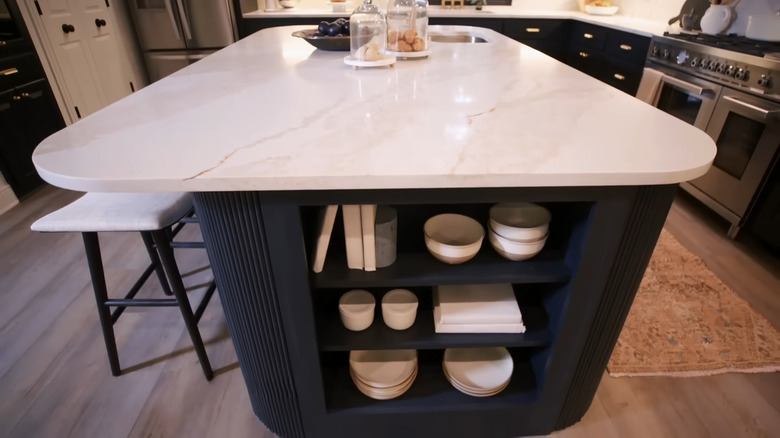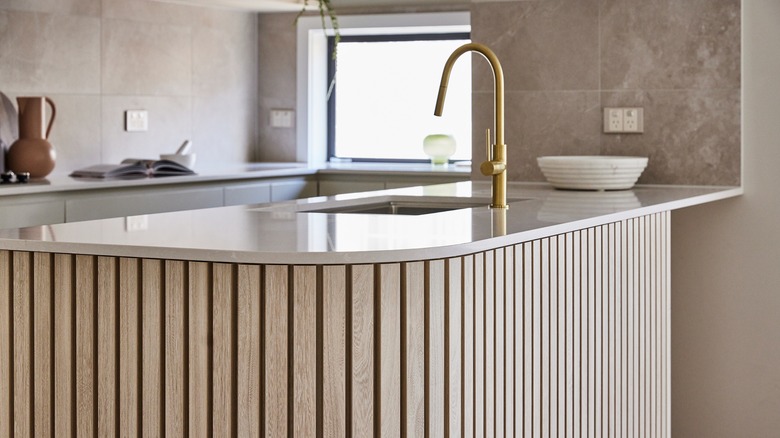Fixer To Fabulous' Jenny Marrs Gets On Board With A Hot Kitchen Design Trend
We may receive a commission on purchases made from links.
Implementing trends in the kitchen can be a tricky business. Yes, you want your space to feel fresh and current, but you also don't want to choose overly trendy countertops, tile, or other fixed features that are expensive to switch out and might quickly date your space. One of the most savvy kitchen renovation tips from the "Fixer to Fabulous" power couple, Dave and Jenny Marrs, is to always opt for timeless finishes over fads. In an interview with Homes & Gardens, Jenny Marrs said, "I recommend staying away from really specific trends and going with classic kitchen cabinets and classic hardware instead." However, there is one recent trend that the HGTV home renovating duo has hopped on, and that is fluting.
Fluted finishes started popping up in interior design during the late 2010s, and reeding began to grace everything from sideboards to organic modern vessels and glass cabinet doors. According to a report released by the National Kitchen and Bathroom Association (via IDI), wood fluting is now an official kitchen trend for 2024. Although fluting feels right at home with organic modern aesthetics, it also pairs perfectly with art deco décor, which happened to be the homeowners' favorite interior style in Season 5, Episode 7 of "Fixer to Fabulous." During this episode, the Marrs tackled a home filled with unique features, like arched doorways and a spacious entryway. Here's how Jenny Marrs incorporated the fluting trend in the kitchen and still achieved a timeless feel.
How Fixer to Fabulous' Jenny Marrs incorporated the wood fluting trend into a stunning kitchen design
It quickly became clear that the homeowners in "A Grand Makeover Meets the Marrs," Laurie Powell and Well Dayshawn, like to entertain and enjoy the generous square footage of their kitchen and dining area. But while spacious, the kitchen needed some serious love. Dave and Jenny Marrs turned it from a '90s time capsule into a classically contemporary and ultra-elegant space by removing the chocolate-toned wood cabinets and the curved, raised bar island. They then installed new (ceiling-height) cabinetry and a large rectangular island, painted in Off-Black by Farrow & Ball — a sophisticated and sexy shade that brought some serious impact.
The original island featured fluted wood on the sides, and Jenny Marrs chose to weave this feature back into her design. However, instead of encasing the entire island in fluting, she only incorporated it on the curved corners, leaving the sides free for recessed shelves and shaker-style drawer fronts. This allowed the fluting to give texture and interest to the island, without dominating the design. The matte black paint helps to tame down the look, letting the reeding blend in smoothly with the cabinetry. The fluting also mirrors the curved corners of the countertop, which seamlessly ties the finish in. Only time can tell how a trend will hold up, but we'd hazard a guess that this discreet use of fluting is subtle enough that it won't scream "2020s" down the road.
Why wood fluting works and how to incorporate it into a kitchen
One of the reasons why Jenny Marrs decided to introduce reeded details into this kitchen renovation probably lies in the fact that fluting isn't just some new fad — on the contrary, it has its roots in ancient Greek architecture. In contemporary settings, fluting helps to add rhythm, depth, and texture. If your kitchen design is feeling a little flat (literally), fluting could be the decorative detail you need. However, be aware that reeded finishes are almost always a little trickier to clean than flat cabinet panels. Thanks to this inescapable fact, you're probably best off using them on cabinet surfaces that aren't likely to see a lot of spills, such as on the outer sides of a kitchen island.
If you aren't looking to demo and reno your kitchen anytime soon, there are still ways you can incorporate this trend. For instance, you may have heard of the IKEA hack to create an affordable, DIY fluted cabinet, which utilizes either pole wrap (found at places like The Home Depot) or half-round molding. To apply this same technique to a kitchen island, use glue and a nail gun, and wrap the front (or wherever else you want to incorporate reeding). Then stain or paint the wood in a shade of your choice. For a renter-friendly solution, you can also try using Command products (such as the Command picture hanging strips that are available on Amazon) to adhere the fluted wood.


